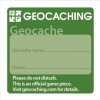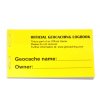Size, difficulty and terrain
Caches differ one from the other, same as people do. You cannot find two that would look the same. Basic parameters that you need to know to find a hidden geocache are Size, Difficulty and Terrain. They can be found in the header of each geocache listing on Geocaching.com, and you can download them to your mobile applications for geocaching game.

Size
Size of the geocache is defined by the owner based on volume of its container. And even though this information is very important for your search (because it eliminates possible hiding spots) it can easily be misleading, especially with geocaches of „other“ size. Think very carefully what you are searching for, so you do not walk away with DNF (did not find).
 Micro
Micro
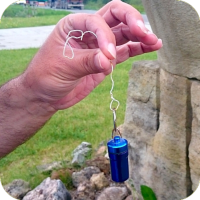
The „Micro“ cache box is smaller than 100ml. Good, and very frequently used, example is box from 35 mm analogue film. Micro cache usually contains just a logbook and a pencil. Nanocaches also belong to this category, they can be a hollow screw or special nanotube with magnet where only small paper strip will fit.
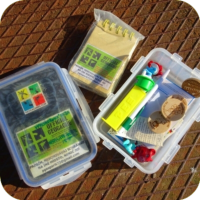
![]() Small
Small
Small Cache`s volume is usually from 100ml to 1l. Most commonly used containers are plastic lunch boxes.
![]() Regular
Regular
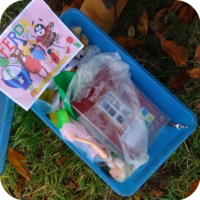
Regular caches are bigger than 1l. Typically these are lock-n-lock boxes or metal ammoboxes the size of a shoe box.
![]() Large
Large
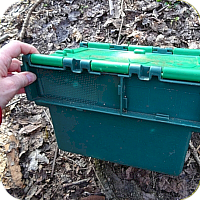
Large cache is very rare, simply because it is difficult to hide it. It is usually a container larger than 20l, e.g paint bucket or plastic barrel. Shipping containers belong to the largest geocaches.
![]() Iná / Other
Iná / Other
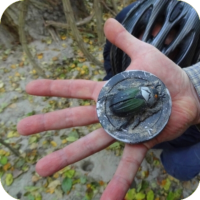
Difficulty
The number of stars should give you an idea how difficult it is to find a cache. There are several ways how to look at it, though. For traditional caches it tells you what effort you need to make to find it, for multicache it tells you how many waypoints (stages) you need to visit, with mystery caches it suggests the difficulty of the riddle you need to solve to get to the final coordinates. Sometimes it can be a combination of all of these factors.
| Cache can be found or solved very quickly, it will only take you couple of minutes. Cache that you find thanks to a good descripton or hint almost immediately are typical examples of this category. Also, Traditional geocaches with one star are the most suitiable for the begginers.
|
|||
|
Cache can be found or solved within 10-15 minutes.
|
|||
|
Search for this cache is relatively easy, it should not take you more than 30 minutes. It is usually traditional cache hidden off the road in the woods, simple multi or mystery cache.
|
|||
|
This rating suggests that some challenge can be expected. Even though the solution may be very easy for experienced cacher, the beginner may need to make some additional effort.
|
|||
|
|||
|
Very difficult task and hiding spot, be prepared to make huge effort. It will be a real challenge.
|
|||
|
Under 4 stars you can find caches that will take lots of time to solve or find, e.g mystery caches with difficult encoding, very long multicaches but also traditional caches hidden so well that you will have to go there on the regular.
|
|||
|
Truly difficult cache, it will cost you a lot of effort. Quite likely it will also require special knowledge or skills.
|
|||
|
Extreme challenge. You will have to learn new things, use special tools and make extra effort to solve, find or open this cache. To find a T-5 caches can also be rather time consuming.
|
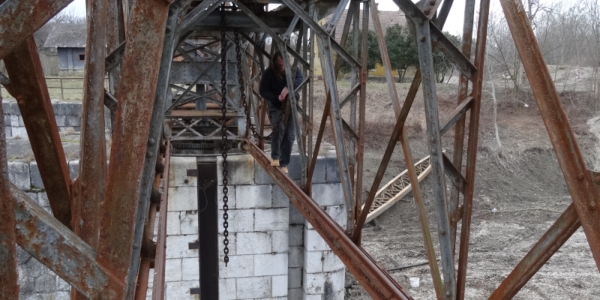
Terrain
Terrain rating suggests how diffitult it is to get to the actual hiding spot. Usually it describes the difficulty of the trip under optimal weather conditions and during a daylight, so if you want to go for a night adventure, add a few more stars to the rating. Each cache can be given only one rating, so if there are any specific terrain changes expected with a change in the weather or time of the year, they should be specifically mentioned in the listing. The given rating should describe the hardest stage of the journey you would have to take to find the physical box.
| The walk should be less then 0.8km (0.5 mile) long with the terrain accessible also for a wheelchair (required attribute) or a stroller. It is almost certain the road will be surfaced and straight. Cache will be placed in a height reachable by a sitting person. If you want to learn how to place a cache that is suitable for physically challenged person, click on a link Handicaching Rating System.
|
||
|
The walk should be less than 0.8km long, with easy terrain without major obstacles, however, it may not be wheelchair accessible.
|
||
|
The trip is usually shorter than 3 km (2 miles), you may need to walk on a surfaced as well as some bumpy road. You don`t need to worry about major changes or elevation of the terrain, but you may expect forrest or field path off the major road.
|
||
|
The trip is usually shorter than 3 km (2 miles), terrain may be a bit bumpy or elevated or you may expect longer walk along the forrest path.
|
||
|
The trip may be longer than 3 km (2 miles). Terrain will be diverse, you may not be able to make it on your bicycle. You may expect lots of ascent, considerable elevation, some obstacles like creeks or impenetrable woods. Be ready to walk also off the road.
|
||
|
This will be obviosly strenuous hike in a difficult terrain or there will be a surprise waiting for you after a pleasant walk. maybe you will need to crawl, climb or slither to get to the desired cache - surely nothing that enthusiastic cacher wouldn`t do.
|
||
|
This trip will require a lot of effort. Either you will have to walk a long way, or gasp for a breath while ascending, or be brave enough to swim or climb. Nevertheless, never search for a 4 star (and higher) cache alone. Human beings are fragile and it is always good to have a companion. Do not be ashamed to ask for help. It is better than get hurt or die trying alone.
|
||
|
Extremely difficult hunt in a dangerous terrain, allowed only for duo or groups. Following the safety rules is critical.
|
||
|
T-5 – nightmare for some yet challenge for the others, require special tools, such as diving equipment, boat, climbing gear etc. Do not forget that you first need to learn how to climb a tree, rock or a dam. Find an experienced climber, there are a few among geocachers, and before you set out for a hunt, train hard. Always visit first few T-5s with the experienced cacher and never take unnecessary risk, it can really cost you a life. |
Text_SKorigin&Pictures: schevka Text_ENG: ZuzkaP.








